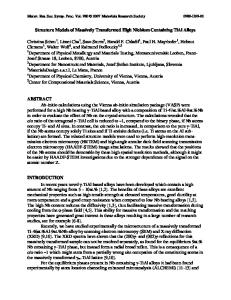Texture Formation in High Niobium Containing TiAl Alloys
- PDF / 2,653,963 Bytes
- 12 Pages / 612 x 792 pts (letter) Page_size
- 103 Downloads / 305 Views
0980-II07-01
Texture Formation in High Niobium Containing TiAl Alloys Andreas Stark1, Arno Bartels1, Frank-Peter Schimansky2, and Helmut Clemens3 1 Institute of Materials Science and Technology, Hamburg University of Technology, Eißendorfer Str. 42, Hamburg, D-21073, Germany 2 Institute for Materials Research, GKSS-Research Centre, Max-Plank-Str. 1, Geesthacht, D21502, Germany 3 Department of Physical Metallurgy and Materials Testing, Montanuniversität Leoben, FranzJosef-Str. 18, Leoben, A-8700, Austria ABSTRACT Texture formation was studied in high Nb bearing γ-TiAl based alloys with compositions of Ti-45Al-(5, 7.5, 10)Nb-(0, 0.5)C (compositions are in atomic percent). In order to start with texture-free material hot-isostatically pressed powder compounds were used. The deformation was performed either in uniaxial compression or by hot rolling. After compression at 700 °C and 800 °C fiber textures with and components occur. These deformation textures can be verified by computer simulations using a yield surface model of γ-TiAl. With higher deformation temperatures the fiber texture vanishes and new accumulations of orientations are formed, which are due to dynamic recrystallization. Hot rolling was performed at temperatures in the upper part of the (α+γ) phase field and, therefore, with more than 50% α-phase existing. The co-deformation of α- and γ-phase during rolling leads to correlated components in the independently measured textures of both phases. The texture of the γ-phase shows a maximum of orientation around the Goss2 component and the texture of the α-phase exhibits an orientation maximum around the transversal component. The correlation is the Blackburn orientation relation, although the textures are not caused by phase transformations, but by co-deformation. Hot rolling with many passes and reheating between the passes lead to the formation of a cube component with an alignment of the c-axes in transverse direction. In general, this is a typical recrystallization-induced component in hot rolled TiAl. INTRODUCTION γ-TiAl based alloys exhibit numerous attractive properties for high-temperature structural applications in industrial and in aviation gas turbines as well as aerospace and automobile industries [1]. In order to extend their service range to higher temperatures research activities have been focused on high Nb bearing TiAl alloys. These so-called TNB alloys exhibit a significant increase in strength combined with improved creep properties and oxidation resistance [2-4]. Several thermo-mechanical processing routes have been established for conventional γ-TiAl based alloys, such as hot rolling, extrusion and forging [1,5]. In this context strong anisotropic mechanical behavior due to the formation of crystallographic textures is often reported [6,7]. Several papers dealing with texture analysis and texture formation of the γ-TiAl phase during hot working have been published in the last years [7-13]. However, little information is available on the deformation behavior and texture evolution of the α
Data Loading...











